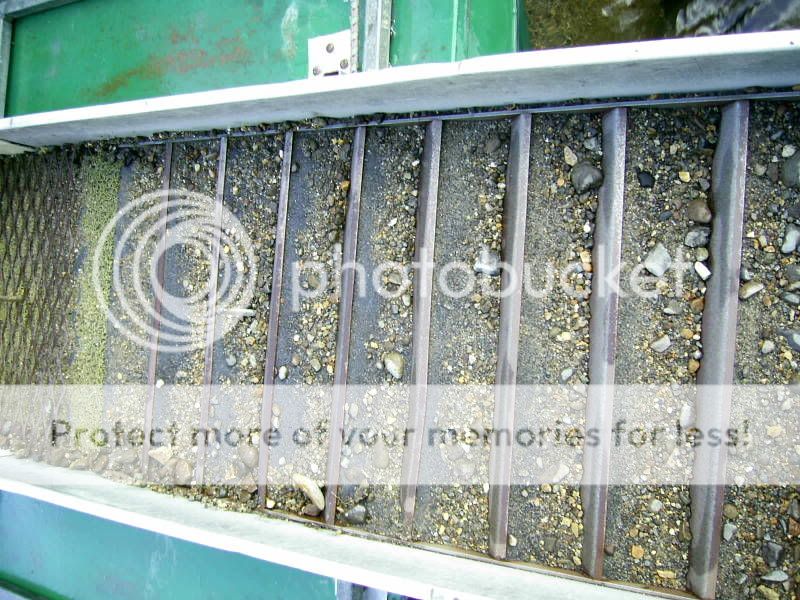this is from the ggpa site hope it helps to give you a basic understanding, PART #1...
Lets REFRESH our memory a little about LEARNING how to read a river or stream. You probably know already, that those locations are the most logical places for finding your Gold. The Gold originally starts out for general purposes in Lode Form. That means, in a hard rock type enviornment. To recover this type of Gold, it takes alot of physical labor and heavy equipment. For example, drill rigs, loaders, dozers, ukes and big dollar items. The average prospector isn't able to obtain these items due to costs and financial operating responsibilities. "SO LETS HAVE MOTHER NATURE DO IT FOR US" Now as time passes us bye, the initial hard rock breaks down, and it releases it's trapped minerals. These minerals start to migrate from the upper levels of the mountain or terrain. As they travel or migrate down the hillside they are commonly known as an Alluvial Deposits. Meaning released gold/deposits that originate and are released from lode deposits. Now we get into the areas where the Gold prospector makes his living. When the Alluvial deposits finally reach a body of water and enter that body of water. They become whats known as Placer Deposits. This is the Gold prospectors typical, Bread and Butter. You ask, why or what do I mean by this statement. Well Lets just review what we've just read. When the Gold is in Lode form, it's very expensive to recover and process. Leaving the average Prospector out of the picture. Now time and erosion, release the gold and it travels to the lowest areas possible. Thats called Alluvial deposit migration, meaning that the Gold is freed up , but scattered all around on it's way down hill. [THIS IS GOOD PROSPECTING FOR THE METAL DETECTORIST]...
But for the Gold Prospector, it's okay but not ideal. To process this Alluvial deposit he would have to get water up on the upper elevations, and have to cover a tremendously large area. Not very cost affordable or practical. In the next phase we hit the bread and butter of Gold prospecting. Mother Nature has done all of the heavy work for us. She wore down the mountain, washed the deposits down the hillside into the creeks/streams and rivers for us. It took wind rain and adverse conditions to get that Gold into the water. Those conditions actually moved the Gold from being sealed up in hard rock, to being freed and now, in Placer Form in the water. "NOW SERIOUSLY THINK ABOUT THAT LAST STATEMENT" READ IT AGAIN, NOW AGAIN...
Once the Gold gets into the water, it's called Placer Gold,[from now on we'll call it that]... Placer Gold moves too !!! It takes rain, lots of water and the seasons of the year to make it move. Since we are in the Southeastern USA, lets keep in mind that the majority of our local river are slow and meandering bodies of water. NOT like our Western States and their rivers, which are subjected to large volumes of SNOW MELT causing tremendous movement of the River beds and adjoining Bank erosion. Are you getting a connection here

Large volumes of water, erosion, river beds being moved. You say,"BUT WE'RE IN THE SOUTHEASTERN USA" we don't have that kind of water volume. My answer to you, "YES WE DO !!!" Here is a major point for you to keep in mind at all times. When planning your Gold Prospecting Adventures, go and check out where you want to go first. What I mean is, wait for the most miserable down pouring rain and flooding conditions that you can negotiate and check out your prospects.
"NOW, DON'T GO JUMPING INTO THE WATER"...
But observe the water flow, where it travels fast, where it slows down. What obstructions are in the water way, ie; stumps, boulders, out croppings, transition zones. Do this when the water is up and running hard. Make a mental note, or better yet "DRAW A SIMPLE MAP"...
This is the time that the river bed and the contents of the river are being moved. That water is moving tons of material, all up and down the river. The areas that you note down now are the areas where you go and look and prospect later. Why you ask

Because later when the water receeds, the the places you saw when the Placer Gold was being moved along with the drop out spots, "NO LONGER EXIST". If you didn't observe the water when it was ripping down stream you would now be looking in all of the wrong places. A slow zone, stump, boulder whatever now, may not be or have had any effect on the Placer Gold when the river was at it's flood stage. In essence, you could very well be looking in the wrong spot. The pay streak or Patches of deposits really aren't where you're looking. Water when being watched or read for Placer deposits during a flood or heavy water flow, will give a different reading from a slow and meandering river. "AND THE PLACER GOLD 99.9% OF THE TIME, ONLY MOVES DURING HIGH WATER PERIODS" Using these methods of research to locate your Placer deposits, "REALLY WORK VERY WELL"...
PART #2
Now onto some definitions you should know
Transition zone;
An area of a river or body of water, where the flow of the water either SLOWS DOWN or SPEEDS UP.
Outcropping;
An object mostly bedrock that protrudes out of or into the water creating an obstacle in the water flow.
PayStreak;
A natural line that the Gold is found to collect around.
Inside Bend;
An area immediately after a bend in a body of water that Gold has a tendency to collect.
Obstruction;
An object that impedes the natural flow of the water during either flood stage or normal flow.
Boil Hole;
A place in the river or body of water where the water continuously blows out the material from a deep hole in the bottom of the waterway.
HardPack;
A natural packing of river bed material, appears almost like it's cemented together. This is caused by natural compaction of the river bottom, when left undisturbed for long periods of time. Many a prospector have been fooled by this false bottom thinking it's the bedrock.
False Bedrock;
This usually occurs when either clay or river rock get compacted together into a hard layer, giving the impression of being the bedrock at the bottom of the river.
OverBurden;
The material in a river or waterway that is between the flowing water and the actual bedrock of that waterway.
Cobbles;
These are the rounded stones or rocks that have been tumbled or moved downstream, wearing them down into rounded assorted rock sizes.
Stratification;
The natural layers of the overburden in a river or waterway. Starting from the lightest of materials [SAND] and progressing in size to the largest material [BOULDERS] as you near the bedrock.
Bedrock;
The actual bottom or hardpan of a river or waterway. The most logical location for finding Gold. Primarily because Gold will always 99% of the time find it's way down to the BedRock.



 Large volumes of water, erosion, river beds being moved. You say,"BUT WE'RE IN THE SOUTHEASTERN USA" we don't have that kind of water volume. My answer to you, "YES WE DO !!!" Here is a major point for you to keep in mind at all times. When planning your Gold Prospecting Adventures, go and check out where you want to go first. What I mean is, wait for the most miserable down pouring rain and flooding conditions that you can negotiate and check out your prospects.
Large volumes of water, erosion, river beds being moved. You say,"BUT WE'RE IN THE SOUTHEASTERN USA" we don't have that kind of water volume. My answer to you, "YES WE DO !!!" Here is a major point for you to keep in mind at all times. When planning your Gold Prospecting Adventures, go and check out where you want to go first. What I mean is, wait for the most miserable down pouring rain and flooding conditions that you can negotiate and check out your prospects.  Smart man T--never mess with a equipment connection!!! My advice would be to go the various forums and there are videos on the web. PM me for a list as I respect Marc a lot and do not want to post a list of the competition. Gotta protect the first forum for miners and respect the man for many MANY years of hard work on this great site
Smart man T--never mess with a equipment connection!!! My advice would be to go the various forums and there are videos on the web. PM me for a list as I respect Marc a lot and do not want to post a list of the competition. Gotta protect the first forum for miners and respect the man for many MANY years of hard work on this great site  -tons a au 2 u 2 -John
-tons a au 2 u 2 -John










